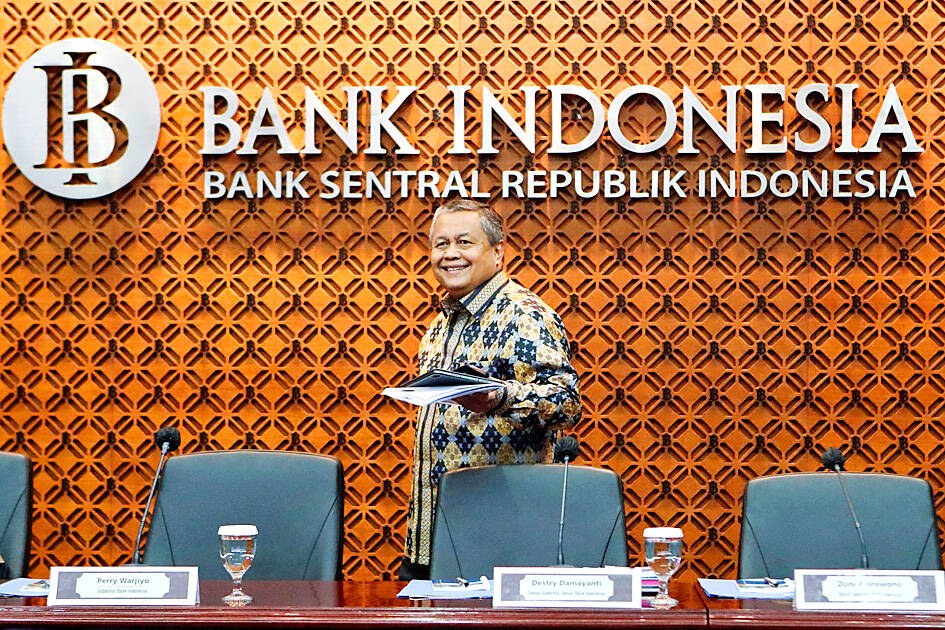Just as the pace of Indonesia’s economic growth returned to pre-COVID-19 pandemic levels, a slowing global economy has emerged as the biggest threat to sustaining that performance.
GDP growth accelerated 5.31 percent last year, bringing Southeast Asia’s largest economy back to its pre-pandemic trajectory of about 5 percent annual growth. That was also the fastest pace since 2013, data yesterday showed.
The “impressive” pace of growth last year was largely supported by domestic consumption, as Indonesia saw a rebound in mobility and tourism, Indonesian Central Statistics Bureau head Margo Yuwono said in a briefing yesterday.

Photo: REUTERS
This was bolstered by exports, as the global commodity rally lifted prices of key shipments such as coal, palm oil, iron and steel, he said.
Although the official forecast is for growth of 4.5 percent to 5.3 percent this year, mounting global risks mean the actual performance could be toward the midpoint, if not lower.
Economists in a Bloomberg survey predict this year’s growth to slow below the psychological 5 percent level to 4.9 percent.
Slowdown in some advanced economies is a key risk. Although the IMF last month raised its forecast for the global economy for the first time in a year, growth in advanced nations is expected to remain weak, damping trade in emerging markets, especially Asia.
Indonesia, the world’s largest exporter of palm oil, saw exports growth tapering in the final months of last year.
That suggests the economy is unlikely to see a repeat of last year’s commodity windfall, which helped lift full-year exports to a record.
“Globally, high prices of Indonesia’s main export commodities supported trade performance last year,” Yuwono said. “However, global commodity prices are already in downward trend, hence will impact growth going forward.”
That is in line with the Indonesian Ministry of Finance’s outlook that weakening global economic activity and higher interest rates could weigh on the nation this year.
The warning signs were apparent in the fourth-quarter figures, with GDP growth at its slowest pace in more than a year.
While exports expanded 15 percent year-on-year, it was softer than the 19.4 percent jump in the July to September period. Consumption growth saw a similar softening to 4.5 percent from 5.4 percent.
Moderating growth means Bank Indonesia, which has increased borrowing costs by 225 basis points since August last year, could be on the verge of its last interest rate increase when it meets later this month.
Bank Indonesia Governor Perry Warjiyo last month indicated that risks from a slowing global economy likely outweigh challenges from inflation, as the central bank slowed the pace of its rate move to a quarter-point.
Headline inflation, which was above the central bank’s 2 percent to 4 percent target for most of last year and likely weighed on consumption, is already showing signs of cooling as gains eased to 5.28 percent last month.

TECH BOOST: New TSMC wafer fabs in Arizona are to dramatically improve US advanced chip production, a report by market research firm TrendForce said With Taiwan Semiconductor Manufacturing Co (TSMC, 台積電) pouring large funds into Arizona, the US is expected to see an improvement in its status to become the second-largest maker of advanced semiconductors in 2027, Taipei-based market researcher TrendForce Corp (集邦科技) said in a report last week. TrendForce estimates the US would account for a 21 percent share in the global advanced integrated circuit (IC) production market by 2027, sharply up from the current 9 percent, as TSMC is investing US$65 billion to build three wafer fabs in Arizona, the report said. TrendForce defined the advanced chipmaking processes as the 7-nanometer process or more

China’s Huawei Technologies Co (華為) plans to start mass-producing its most advanced artificial intelligence (AI) chip in the first quarter of next year, even as it struggles to make enough chips due to US restrictions, two people familiar with the matter said. The telecoms conglomerate has sent samples of the Ascend 910C — its newest chip, meant to rival those made by US chipmaker Nvidia Corp — to some technology firms and started taking orders, the sources told Reuters. The 910C is being made by top Chinese contract chipmaker Semiconductor Manufacturing International Corp (SMIC, 中芯) on its N+2 process, but a lack

Who would not want a social media audience that grows without new content? During the three years she paused production of her short do-it-yourself (DIY) farmer’s lifestyle videos, Chinese vlogger Li Ziqi (李子柒), 34, has seen her YouTube subscribers increase to 20.2 million from about 14 million. While YouTube is banned in China, her fan base there — although not the size of YouTube’s MrBeast, who has 330 million subscribers — is close to 100 million across the country’s social media platforms Douyin (抖音), Sina Weibo (新浪微博) and Xiaohongshu (小紅書). When Li finally released new videos last week — ending what has

OPEN SCIENCE: International collaboration on math and science will persevere even if the incoming Trump administration imposes strict controls, Nvidia’s CEO said Nvidia Corp CEO Jensen Huang (黃仁勳) said on Saturday that global cooperation in technology would continue even if the incoming US administration imposes stricter export controls on advanced computing products. US president-elect Donald Trump, in his first term in office, imposed restrictions on the sale of US technology to China citing national security — a policy continued under US President Joe Biden. The curbs forced Nvidia, the world’s leading maker of chips used for artificial intelligence (AI) applications, to change its product lineup in China. The US chipmaking giant last week reported record-high quarterly revenue on the back of strong AI chip